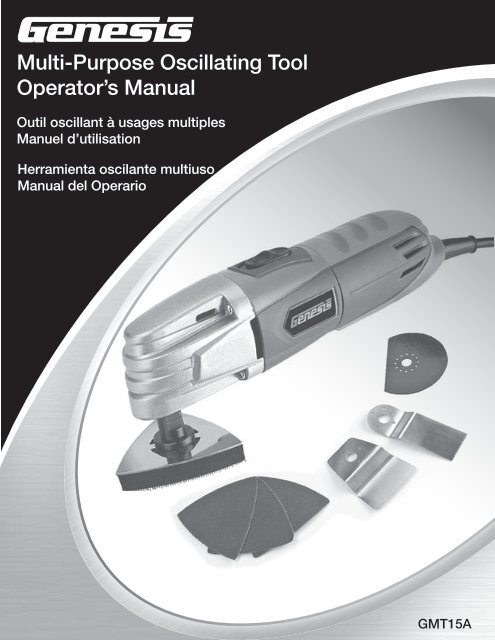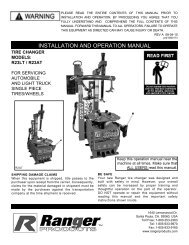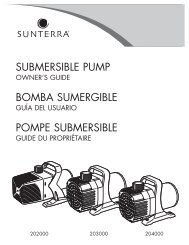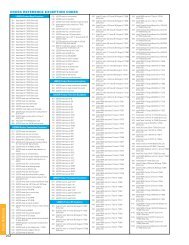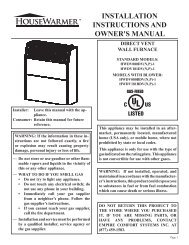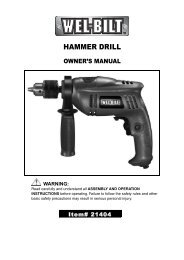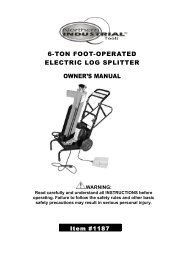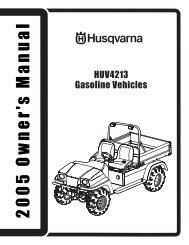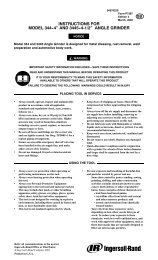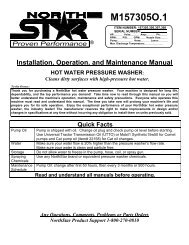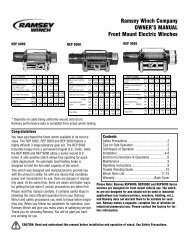Multi-Purpose Oscillating Tool Operator's Manual
Multi-Purpose Oscillating Tool Operator's Manual
Multi-Purpose Oscillating Tool Operator's Manual
Create successful ePaper yourself
Turn your PDF publications into a flip-book with our unique Google optimized e-Paper software.
<strong>Multi</strong>-<strong>Purpose</strong> <strong>Oscillating</strong> <strong>Tool</strong><br />
Operator’s <strong>Manual</strong><br />
Outil oscillant à usages multiples<br />
Manuel d’utilisation<br />
Herramienta oscilante multiuso<br />
<strong>Manual</strong> del Operario<br />
GMT15A
English<br />
<strong>Multi</strong>-<strong>Purpose</strong> <strong>Oscillating</strong> <strong>Tool</strong> 1.5 AMP<br />
Operator’s <strong>Manual</strong><br />
Specifications:<br />
• Model: GMT15A<br />
• Rated Input: 120V~AC, 60HZ, 1.5A<br />
• No Load Speed: 21,000/min (OPM)<br />
Includes: <strong>Oscillating</strong> <strong>Tool</strong>, Hook & Loop Sanding Pad, Assorted Sandpaper, Rigid Scraper Blade, 1-3/16" (30mm) E-Cut (Flush Cut) Saw Blade, 3” Wood &<br />
Drywall Saw Blade, and Wrench<br />
WArnIng:<br />
To reduce the risk of injury, user must read and understand this operator’s manual before operating this tool. Save this<br />
<strong>Manual</strong> for future reference.<br />
Toll-Free Help Line: 1-888-552-8665.<br />
WEAR yOuR<br />
SAFETy GLASSES<br />
FORESIGHT IS BETTER<br />
THAN NO SIGHT<br />
WArnIng:<br />
The Operation of any power tool can result in foreign objects being thrown into your eyes, which can result in severe eye damage.<br />
Before beginning tool operation, always wear safety goggles or safety glasses with side shields and a full face shield when needed.<br />
We recommend Wide Vision Safety Mask for use over eyeglasses or standard safety glasses with side shields. Always wear eye<br />
protection which is marked to comply with ANSI Z87.1.<br />
Look for this symbol to point out important safety precautions.<br />
It means attention!!! Your safety is involved.<br />
gEnErAL SAFETY rULES<br />
WArnIng:<br />
Some dust created by power sanding, sawing, grinding, drilling, and other construction activities contains chemicals<br />
known to cause cancer, birth defects or other reproductive harm. Some examples of these chemicals are:<br />
• lead from lead-based paints,<br />
• crystalline silica from bricks and cement and other masonry products, and<br />
• arsenic and chromium from chemically treated lumber.<br />
Your risk from these exposures varies, depending on how often you do this type of work. To reduce your exposure to<br />
these chemicals: work in a well ventilated area, and work with approved safety equipment, such as those dust masks<br />
that are specially designed to filter out microscopic particles.<br />
<strong>Multi</strong>-<strong>Purpose</strong> <strong>Oscillating</strong> <strong>Tool</strong><br />
Operator’s <strong>Manual</strong> GMT15A
English<br />
WArnIng:<br />
rEAD AnD UnDErSTAnD ALL WArnIngS, CAUTIOnS AnD OPErATIng InSTrUCTIOnS BEFOrE USIng THIS<br />
EQUIPMEnT. Failure to follow all instructions listed below may result in electric shock, fire and/or serious<br />
personal injury.<br />
WORK AREA SAFETY:<br />
SAVE THESE INSTRUCTIONS<br />
• Keep your work area clean and well lit. Cluttered benches and dark areas invite accidents.<br />
• Do not operate power tools in explosive atmospheres, such as in the presence of flammable liquids, gases, or dust.<br />
Power tools create sparks which may ignite the dust or fumes.<br />
• Keep bystanders, children, and visitors away while operating a power tool. Distractions can cause you to lose<br />
control.<br />
ELECTRICAL SAFETY<br />
• Power tool plugs must match the outlet. Never modify the plug in any way. Do not use any adapter plugs in any earthed<br />
(grounded) power tools. Double insulated tools are equipped with a polarized plug (one blade is wider than the other). This plug will fit in a<br />
polarized outlet only one way. If the plug does not fit fully in the outlet, reverse the plug. If it still does not fit, contact a qualified electrician to<br />
install a polarized outlet. Do not change the plug in any way. Double insulation eliminates the need for the three wire grounded power cord and<br />
grounded power supply system.<br />
• Do not expose power tools to rain or wet conditions. Water entering a power tool will increase the risk of electric<br />
shock.<br />
• Avoid body contact with earthed or grounded surfaces such as pipes, radiators, ranges and<br />
refrigerators. There is an increased risk of electric shock if your body is grounded.<br />
• Do not abuse the cord. Never use the cord for carrying, pulling or unplugging the power tool. Keep cord away from heat, oil, sharp<br />
edges or moving parts. Damaged cords increase the risk of electric shock.<br />
• When operating a power tool outside, use an extension cord suitable for outdoor use. These cords are<br />
rated for outdoor use and reduce the risk of electric shock.<br />
• Do not use AC only rated tools with a DC power supply. While the tool may appear to work. The electrical components<br />
of the AC rated tool are likely to fail and rate a hazard to the operator.<br />
PERSONAL SAFETY<br />
• Stay alert, watch what you are doing and use common sense when operating a power tool. Do not use tool while tired or under the<br />
influence of drugs, alcohol, or medication. A moment of inattention while operating power tools may result in serious personal injury.<br />
• Use safety equipment. Always wear eye protection. Safety equipment such as dust mask, non-skid safety shoes, hard hat, or hearing<br />
protection for appropriate conditions will reduce personal injuries.<br />
• Dress properly. Do not wear loose clothing or jewelry. Keep your hair, clothing and gloves away from moving parts. Loose clothes,<br />
jewelry or long hair can be caught in moving parts. Air vents may cover moving parts and should be avoided.<br />
• Avoid accidental starting. Ensure the switch is in the off position before plugging in. Carrying power tool with your finger on the<br />
switch or plugging in power tools that have the switch on invites accidents.<br />
• Remove any adjusting keys or wrenches before turning the power tool on. A wrench or key that is left<br />
attached to a rotating part of the tool may result in personal injury.<br />
• Do not overreach. Maintain proper footing and balance at all times. Loss of balance can cause an injury in an unexpected situation.<br />
• If devices are provided for connection of dust extraction and collection facilities, ensure these are<br />
connected and properly used. use of these devices can reduce dust related hazards.<br />
• Do not use a ladder or unstable support. Stable footing on a solid surface enables better control of the tool in unexpected<br />
situations.<br />
• Keep tool handles dry, clean and free from oil and grease. Slippery handles cannot safely control the tool.<br />
TOOL USE AND CARE<br />
• Secure the work piece. use clamp or other practical way to hold the work piece to a stable platform. Holding the work piece by hand<br />
or against your body is unstable and may lead to loss of control.<br />
<strong>Multi</strong>-<strong>Purpose</strong> <strong>Oscillating</strong> <strong>Tool</strong><br />
Operator’s <strong>Manual</strong> GMT15A
English<br />
• Do not force the power tool. The tool will perform the job better and safer at the feed rate for which it is designed. Forcing the tool<br />
could possibly damage the tool and may result in personal injury.<br />
• Use the correct power tool for the job. Don’t force the tool or attachment to do a job for which it is not designed.<br />
• Do not use tool if switch does not turn it on or off. Any tool that cannot be controlled with the switch is dangerous and<br />
must be repaired or replaced by an authorized service center.<br />
• Turn power tool off, and disconnect the plug from the power source and/or battery pack from the power tool before making<br />
any adjustments, changing the accessories, or storing the tools. Such preventive safety measures reduce the risk of an accidental start up<br />
which may cause personal injury.<br />
• Store idle tool out of reach of children and other inexperienced persons. It is dangerous in the hand of untrained<br />
users.<br />
• Maintain power tools with care. Check for proper alignment and binding of moving parts, component breaks, and any other<br />
conditions that may affect the tool’s operation. A guard or any other part that is damaged must be properly repaired or replaced by an<br />
authorized service center to avoid risk of personal injury.<br />
• Use recommended accessories. using accessories and attachments not recommended by the manufacturer or intended for<br />
use on this type tool may cause damage to the tool or result in personal injury to the user. Consult the operator’s manual for recommended<br />
accessories.<br />
• Keep cutting tools sharp and clean. Properly maintained cutting tools with sharp cutting edges are less likely to bind and are<br />
easier to control.<br />
• Feed the work piece in the correct direction and speed. Feed the work piece into a blade, cutter, or abrasive surface<br />
against the direction of the cutting tool’s direction of rotation only. Incorrectly feeding the work piece in the same direction may cause the work<br />
piece to be thrown out at high speed.<br />
• Never leave the tool running unattended, turn the power off. Do not leave the tool until it comes to a complete stop.<br />
• Never start the power tool when any rotating component is in contact with the work piece.<br />
WArnIng:<br />
USE OF THIS TOOL CAn gEnErATE AnD DISBUrSE DUST Or OTHEr AIrBOrnE PArTICLES, InCLUDIng WOOD<br />
DUST, CrYSTALLInE SILICA DUST AnD ASBESTOS. Direct particles away from face and body. Always operate<br />
tool in a well-ventilated area and provide for proper dust removal. Use dust collection system wherever possible.<br />
Exposure to the dust may cause serious and permanent respiratory or other injury, including silicosis (a serious lung<br />
disease), cancer, and death. Avoid breathing the dust, and avoid prolonged contact with the dust. Allowing dust to<br />
get into your mouth or eyes, or lay on your skin may promote absorption of harmful material. Always use properly<br />
fitting nIOSH/OSHA approved respiratory protection appropriate for dust exposure, and wash exposed areas with<br />
soap and water.<br />
SERVICE<br />
• Have Your Power <strong>Tool</strong> Serviced by a qualified repair person using only identical replacement parts.<br />
This will ensure that the safety of the power tool is maintained.<br />
• Service Your Power <strong>Tool</strong> periodically. When cleaning a tool, be careful not to disassemble any portion of the tool since internal<br />
wires may be misplaced or pinched.<br />
WArnIng:<br />
rEAD AnD UnDErSTAnD ALL WArnIngS, CAUTIOnS AnD OPErATIng InSTrUCTIOnS BEFOrE USIng THIS<br />
EQUIPMEnT. Failure to follow all instructions listed below may result in electric shock, fire and/or serious<br />
personal injury.<br />
SAVE THESE INSTRUCTIONS<br />
<strong>Multi</strong>-<strong>Purpose</strong> <strong>Oscillating</strong> <strong>Tool</strong><br />
Operator’s <strong>Manual</strong> GMT15A
English<br />
EXTEnSIOn COrDS<br />
grounded tools require a three wire extension cord. Double insulated tools can use either a two or three wire extension cord.<br />
As the distance from the power supply outlet increases, you must use a heavier gauge extension cord. using extension cords with inadequately sized<br />
wire causes a serious drop in voltage, resulting in loss of power and possible tool damage. Refer to the table shown below to determine the required<br />
minimum wire size.<br />
The smaller the gauge number of the wire, the greater the capacity of the cord. For example: a 14-gauge cord can carry a higher current than a 16gauge<br />
cord. When using more than one extension cord to make up the total length, be sure each cord contains at least the minimum wire size required.<br />
If you are using one extension cord for more than one tool, add the nameplate amperes and use the sum to determine the required minimum wire size.<br />
guidelines for Using Extension Cords<br />
• If you are using an extension cord outdoors, be sure it is marked with the suffix “W-A” (“W” in Canada) to indicate that it is acceptable for outdoor use.<br />
• Be sure your extension cord is properly wired and in good electrical condition. Always replace a damaged extension cord or have it repaired by a<br />
qualified person before using it.<br />
• Protect your extension cords from sharp objects, excessive heat, and damp or wet areas.<br />
Recommended Minimum Wire Gauge for Extension Cords (120 Volt)<br />
Nameplate<br />
Amperes<br />
(At Full Load)<br />
Extension Cord Length<br />
25 Feet 50 Feet 75 Feet 100 Feet 150 Feet 200 Feet<br />
0–2.0 18 18 18 18 16 16<br />
2.1–3.4 18 18 18 16 14 14<br />
3.5–5.0 18 18 16 14 12 12<br />
5.1–7.0 18 16 14 12 12 10<br />
7.1–12.0 18 14 12 10 8 8<br />
12.1–16.0 14 12 10 10 8 6<br />
16.1–20.0 12 10 8 8 6 6<br />
SPECIFIC SAFETY rULES FOr MULTI-PUrPOSE OSCILLATIng TOOLS<br />
WArnIng: DO nOT LET COMFOrT Or FAMILIArITY WITH PrODUCT (gAInED FrOM rEPEATED USE)<br />
rEPLACE STrICT ADHErEnCE TO PrODUCT SAFETY rULES. If you use this tool unsafely or incorrectly, you can<br />
suffer serious personal injury!<br />
WArnIng: Hold tool by insulated gripping surfaces when performing an operation where cutting tools may<br />
contact hidden wiring or its own cord. Contact with a “live” wire will make exposed metal parts of the tool “live” and<br />
shock the operator!<br />
• Always wear safety glasses or goggles. Normal prescription eye or sunglasses are not safety glasses.<br />
• Hold the <strong>Oscillating</strong> <strong>Tool</strong> by its insulated gripping surfaces to avoid electrical shock from unseen<br />
“live” wires.<br />
• Always hold the tool firmly. DO not leave the tool running unless hand held.<br />
• Check your work area for proper clearances before cutting. This will avoid cutting into your workbench, the floor, etc.<br />
• DO not cut nails or screws unless you are using a blade specifically designed for this purpose. Inspect your material before cutting.<br />
• Before switching on the tool, be sure the blade is not contacting the work piece.<br />
• Do not use tool if switch does not turn it on or off. Any tool which can not be controlled by the switch is dangerous and<br />
must be repaired.<br />
• Wear cushioned protective gloves to minimize the vibration. Excessive vibration may cause personal injury.<br />
• Do not wet-sand with this tool. Water or moisture entering the motor housing can cause electric shock and serious personal<br />
injury.<br />
• Always be sure that the tool is switched off and unplugged before adjusting, adding accessories, or checking<br />
a function on the tool.<br />
<strong>Multi</strong>-<strong>Purpose</strong> <strong>Oscillating</strong> <strong>Tool</strong><br />
Operator’s <strong>Manual</strong> GMT15A
English<br />
WArnIng:<br />
USE OF THIS TOOL CAn gEnErATE AnD DISBUrSE DUST Or OTHEr AIrBOrnE PArTICLES, InCLUDIng WOOD<br />
DUST, CrYSTALLInE SILICA DUST AnD ASBESTOS. Direct particles away from face and body. Always operate<br />
tool in a well-ventilated area and provide for proper dust removal. Use dust collection system wherever possible.<br />
Exposure to the dust may cause serious and permanent respiratory or other injury, including silicosis (a serious lung<br />
disease), cancer, and death. Avoid breathing the dust, and avoid prolonged contact with the dust. Allowing dust to<br />
get into your mouth or eyes, or lay on your skin may promote absorption of harmful material. Always use properly<br />
fitting nIOSH/OSHA approved respiratory protection appropriate for dust exposure, and wash exposed areas with<br />
soap and water.<br />
YOUr MULTI-PUrPOSE OSCILLATIng TOOL<br />
1. ON/OFF Switch<br />
2. Cast Aluminum Gear Head<br />
3. <strong>Oscillating</strong> Spindle and Blade holder<br />
4. Flush Cutting Blade 1-3/16”<br />
5. 3” Wood and Drywall saw Blade<br />
6. Rigid Scraper blade<br />
7. Hook & Loop Sanding Pad<br />
8. Sandpaper<br />
Unpacking and Content<br />
IMPOrTAnT: Due to modern mass production techniques, it is unlikely the tool is faulty or that a part<br />
is missing. If you find anything wrong, do not operate the tool until the parts have been replaced or the<br />
fault has been rectified. Failure to do so could result in serious personal injury.<br />
Contents in Package:<br />
Description QTY<br />
<strong>Oscillating</strong> <strong>Tool</strong> 1<br />
1-3/16” (30mm)Flush Saw Blade 1<br />
3” Wood and Drywall Saw Blade 1<br />
Rigid Scraper Blade 1<br />
Hook & Loop Sanding Pad 1<br />
Sandpaper 3<br />
Allen Wrench 1<br />
Cap screw and washers 1<br />
Operator’s <strong>Manual</strong> 1<br />
3<br />
<strong>Multi</strong>-<strong>Purpose</strong> <strong>Oscillating</strong> <strong>Tool</strong><br />
Operator’s <strong>Manual</strong> GMT15A<br />
2<br />
7<br />
1<br />
8<br />
6<br />
5<br />
4
English<br />
ASSEMBLY AnD ADJUSTMEnTS<br />
WArnIng: Always be sure that the tool is switched off and unplugged before adjusting, adding<br />
accessories, or checking a function on the tool<br />
To install the saw blade or scraper blade<br />
1. Loosen and remove the cap screw (a) and large blade washer from the shaft flange using Allen wrench provided. (FIG 1)<br />
2. Place the accessory over the shaft flange (b). The shaft flange of this tool comes with a 4-pin design. Make sure the holes on the accessory<br />
properly engage those 4 pins and the accessory is flush against the shaft flange.<br />
3. Put the cap screw and washer back on. Make sure the concave side of the large blade washer is facing the accessory. Tighten the cap screw<br />
securely using Allen wrench (c) provided. (See FIG 1)<br />
c<br />
a<br />
nOTE: Some accessories, such as a saw blade, may be mounted either straight on the tool, or at an angle to<br />
enhance usability. Always make sure the 4 pins are engaged as in step 2 above.<br />
To install the Sanding pad and Sandpaper<br />
1. Loosen and remove the cap screw (a), and large blade washer from the shaft flange.<br />
2. Place hook & loop sanding pad (7) against the shaft flange(b), make sure to position it with one tip facing straight forward. Make sure that the 4<br />
pins on the shaft flange fully engage the sanding pad, and that the pad is flush against the shaft flange. (See FIG 1).<br />
3. Put only the cap screw back on (without washers). Tighten it to secure the sanding pad on shaft flange.<br />
4. Align the sandpaper (8) and press it onto the sanding pad by hand. Turn the tool over, and firmly press the sandpaper against a flat surface to<br />
secure the hook and loop paper. (See FIG 1)<br />
nOTE: For maximum sandpaper life, rotate the pad or sandpaper 120 degrees when tip of sandpaper becomes worn.<br />
WArnIng: DO nOT tighten the cap screw unless the accessory is properly seated on the shaft flange.<br />
To remove accessories from the tool, simply just reverse the above procedures.<br />
OPErATIOn<br />
WArnIng: Always be sure the tool is disconnected from the power source before making any adjustments or<br />
setting up prior to cutting. Failure to disconnect or unplug the tool may cause accidental starting, resulting in serious<br />
personal injury.<br />
STArTIng AnD STOPPIng THE OSCILLATIng TOOL<br />
8<br />
a<br />
7<br />
To start the oscillating tool, slide the ON/OFF switch forward to ON position. (FIG 2 )<br />
To stop the oscillating tool, slide the ON/OFF switch backward to OFF position. (FIG 2)<br />
<strong>Multi</strong>-<strong>Purpose</strong> <strong>Oscillating</strong> <strong>Tool</strong><br />
Operator’s <strong>Manual</strong> GMT15A<br />
b<br />
FIG 1<br />
FIG 2
English<br />
APPLICATIOnS<br />
nOTE: This tool must be used only with gEnESIS oscillating tool accessories. See Accessories Chart for details.<br />
This multi-purpose oscillating tool is intended for cutting and sanding wood, plastic, plaster and non-ferrous metals. It is especially suitable for<br />
cutting in tight spaces and for flush cutting. Following are a few typical uses.<br />
Cutting:<br />
use a flush cutting saw blade (or “e-cut blade”) for making precise cuts in tight areas, close to edges or flush to a surface. It is important not<br />
to force the tool during the flush cutting. If you are experiencing a strong vibration in your hand during the plunge cut, it indicates too much<br />
pressure on the tool. Back off on the pressure and let the speed of tool do the work. See FIG 3, FIG 4 for typical uses of flush cutting saw blade.<br />
nOTE: It is suggested that you have a piece of scrap material supporting the blade when making a flush cut.<br />
If you need to rest the blade on a delicate surface, you need to use cardboard or masking tape to protect the<br />
surface.<br />
FIG 3 FIG 4 FIG 5<br />
use the half-round flat saw blade (5) for making precise cuts in wood, plaster or drywall material. Applications include cutting openings for<br />
electrical boxes, repairing flooring, cutting flooring for venting, and more. See FIG 5 for use of flat saw blade.<br />
Sanding<br />
With sanding accessories, this tool is a detail sander. It is suitable for dry sanding of wood, plastic, and metal surfaces, especially in corners,<br />
edges and hard to reach areas. See FIG 6<br />
Tips:<br />
1. Work with the complete surface of the sandpaper, not only with the tip.<br />
2. Sand with continuous motion and light pressure. Do not apply excessive pressure. Let tool do the work.<br />
3. Always secure small work pieces.<br />
4. Select suitable abrasive paper for best results.<br />
Scraping<br />
Scraper blades are suitable for removing vinyl, varnish, paint layers, carpeting, caulk and other adhesives.<br />
use a rigid scraper blade to remove harder materials, such as vinyl flooring, carpeting and tile adhesives in large area.<br />
use a flexible scraper blade (not included) to remove softer material such as caulk. See FIG 7<br />
Tips:<br />
1. When removing strong, tacky adhesive, grease the scraper blade surface to reduce gumming up.<br />
2. Begin with light pressure. The oscillating motion of accessory only occurs when pressure is applied<br />
to the material to be removed.<br />
3. If you are removing caulk from a delicate surface, such as a bath tub or tile back splash, we<br />
recommend taping to protect the surface that blade will rest on.<br />
grout removal<br />
use a grout removal blade (not included) to remove damaged or cracked grout, or in order to replace<br />
a damaged or broken tile.<br />
To remove the grout, use a back and forth motion, making several passes along the grout line. Be<br />
careful not to apply too much side pressure on the grout blade. See FIG 8<br />
<strong>Multi</strong>-<strong>Purpose</strong> <strong>Oscillating</strong> <strong>Tool</strong><br />
Operator’s <strong>Manual</strong> GMT15A<br />
FIG 6<br />
FIG 7<br />
FIG 8
English<br />
ACCESSOrIES<br />
nOTE: This tool must be used only with gEnESIS oscillating tool accessories.<br />
Model Picture Description Recommended Application<br />
GAMT301<br />
GAMT302<br />
GAMT303<br />
GAMT304<br />
GAMT305<br />
GAMT306<br />
MAInTEnAnCE<br />
CLEANING<br />
Flush Cut Saw Blade Assortment<br />
Pack,<br />
<strong>Multi</strong>-<strong>Purpose</strong> <strong>Oscillating</strong> <strong>Tool</strong><br />
Operator’s <strong>Manual</strong> GMT15A<br />
Cutting and flush cuts in Wood, Plastic, Drywall and<br />
other soft materials.<br />
Size: 3/8" (10mm), For example:<br />
Size: 3/4" (20mm), -Flush cutting door jamb or base molding.<br />
Size: 1-3/16" (30mm) -Cut-outs in furniture for cable connections.<br />
3" Wood & Drywall Saw Blade<br />
(HSS)<br />
1/8” Grout Removal Blade<br />
Scraper Blade Twin pack:<br />
Rigid Scraper Blade(Left)<br />
Flexible Scraper Blade(Right)<br />
Sandpaper Assortment Pack<br />
(3) 60 grit, (3) 80 grit, (3) 120<br />
grit, (3) 240 grit<br />
Bi-Metal Flush Cut Saw Blade<br />
for Metal and Wood, 1-3/8"<br />
(35mm)<br />
Cutting in Wood, Plastic, Drywall and other Soft<br />
Materials.<br />
For example<br />
-Cutting opening in flooring for venting<br />
-Cutting opening for electrical boxes<br />
For removing grout from floor or wall tiles for<br />
replacement or restoration.<br />
-Rigid Scraper Blade to remove vinyl flooring and<br />
bonded carpeting, old coats of varnish/paint and other<br />
adhesives.<br />
-Flexible Scraper Blade to remove caulk, coats of<br />
peeling paint or soft adhesives.<br />
For detail sanding.<br />
Cutting or flush cuts in non-ferrous metals, wood,<br />
plastic,drywall and other soft materials.<br />
For example:<br />
-Cutting Cutting copper pipe<br />
-Cable ducts flush against walls, floors or ceilings<br />
Avoid using solvents when cleaning plastic parts. Most plastics are susceptible to damage from various types of commercial solvents and may be<br />
damaged by their use. use clean cloths to remove dirt, dust, oil, grease, etc.<br />
WArnIng: Do not at any time let brake fluids, gasoline, petroleum-based products, penetrating oils, etc., come<br />
in contact with plastic parts. Chemicals can damage, weaken or destroy plastic which may result in serious personal<br />
injury.<br />
Electric tools used on fiberglass material, wallboard, spackling compounds, or plaster are subject to accelerated wear and possible premature failure<br />
because the fiberglass chips and grindings are highly abrasive to bearings, brushes, commutators, etc. Consequently, we do not recommended using<br />
this tool for extended work on these types of materials. However, if you do work with any of these materials, it is extremely important to clean the tool<br />
using compressed air.<br />
LUBRICATION<br />
This tool is permanently lubricated at the factory and requires no additional lubrication.<br />
TWO-YEAr WArrAnTY<br />
This product is warranted free from defects in material and workmanship for 2 years after date of purchase. This limited warranty does not cover normal<br />
wear and tear or damage from neglect or accident. The original purchaser is covered by this warranty and it is not transferable. Prior to return your tool<br />
to store location of purchase, please call Toll-Free Help Line for possible solutions. THIS PRODUCT IS NOT WARRANTED IF USED FOR INDUSTRIAL OR<br />
COMMERCIAL PURPOSES.<br />
TOLL-FrEE HELP LInE<br />
For questions about this or any other GENESIS Product, please call Toll-Free: 888-552-8665.<br />
Or visit our website: www.richpowerinc.com
Notes
Notes<br />
Notes
Richpower Industries, Inc.<br />
736 Hampton Road<br />
Williamston, SC USA<br />
www.richpowerinc.com


